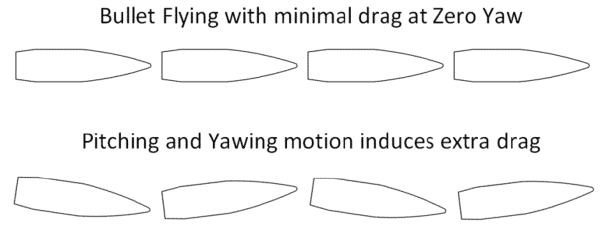The are many benefits to understanding and matching the twist rate of your barrel with the projectile weight you are using. Primarily, accuracy. This article is a high-level overview of the subject, and as such, a few concepts and terms are simplified. If you want a truly in-depth study of the subject – get Brian Litz’s series of books from Applied Ballistics. If you want functional information, read on.
Too fast a twist rate and the projectile can potentially damage the projectile jacket as the excessive force separates the jacket from the core. As we get faster and faster twist rates – this is becoming more of an issue. I personally know a few guys with 1:7.5 Creedmoors that are having the Hornady Match projectiles spinning their jackets off on them mid-air.
Twist rates and bullet weight are often MISUNDERstood, but there are some simple and practical guidelines.
But first, a little background.
TWIST RATE
You can read an expanded article on twist rate over here – but in summary, a twist rate is the number of times your rifling (the groove in your firearm barrel) makes a full revolution over a set distance – this is generally expressed in inches – so a “1 in 10” makes one revolution of rifling every ten inches of barrel length.
BULLET WEIGHT
Bullet weight has increased as we are reached out further and further with our rifles.
A heavier projectile (more grains) will often come with a better (higher BC) – that is, the ability of the projectile to buck wind – they fly truer, for longer.

However, it’s not just as simple as putting the heaviest bullet you can down the barrel. More weight requires more powder to move – and speed is still a priority as a slow-moving bullet spends more time in the air, has more time to be affected by the wind, and in the understanding that everything drops at the same speed (thanks, gravity!) the faster it moves, the further it can reach with less ballistic drop.
MATCHING TWIST RATES AND BULLET WEIGHT
So, in very simple terms, the heavier the projectile (it is actually a function of bullet length and sectional density, but we are simplifying things here), the faster (lower number) twist rate you are likely to want to utilise.
I know, I know, just tell us already – what do I put in my rifle?
Well – here is a very basic chart that will set you off on the right foot. Like all things reloading, there are always exceptions.
| Twist Rate | Projectile Weight |
|---|---|
| .224 / 5.56 (your .223 Ar) | |
| 1:16 | Up to 55 grains, 4300 fps or more |
| 1:15 | Up to 55 grains, 4100 to 4300 fps |
| 1:14 | Up to 55 grains, less than 4100 fps |
| 1:12 | 55-63 grains |
| 1:9 | 63-70 grains |
| 1:8 | 70 grains or more |
| 6.5mm | |
| 1:9 | Up to 130 grains |
| 1:8 | 130 grains or more |
| .308 | |
| 1:15 | up to 150 grains |
| 1:14 | 150 to 168 grains |
| 1:12 | 168 to 170 grains |
| 1:10 | 170 to 220 grains |
| 1:8 | 220 grains or more |
This is just a quick list to give you an idea.
But wait… There’s more!
Want to get the rest of the article? Then simply join up as a member and gain access to all the extra content here and over on The Bloke!
For around the cost of a cup of coffee per month (in Auckland, I do admit) you support the projects, get extra content and become an all-around good bloke.
Click the button, join up, then refresh this page here to get all the extra content!
In this article – seven simple steps you can take to start reducing your ES/SD right now!
[membership level=”2,3,4,5″]
[/membership]
OVERSTABILISING THE ELD-M PROJECTILE.
I recently have had a good mate who has been destroying ELD-M’s with abondon.
It’s a 1:7.5 Twist, chambered for 6.5 PRC and he is getting projectiles disintegrating mid-flight. Too be fair – he is running right at the ragged edge of velocity/pressure/speed and the resulting twist these things are undergoing – but – it’s not super crazy what he is doing.
If you have a projectile that just seems to be going a little crazy – or – even missing rounds on target – it might be worth considering if we have managed to out twist some of the options on the market.


